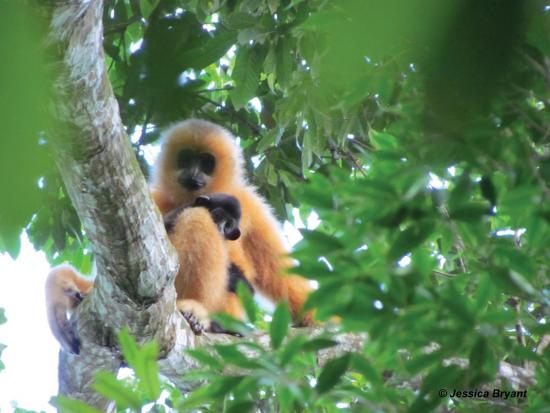Bringing the Hainan Gibbon Back from the Brink
CBSG facilitated and provided modeling support at an international workshop for Hainan gibbons, which are some of the most endangered primates in the world.

Facts:
- The entire Hainan gibbon population of only 23-25 individuals is restricted to about 15km2 of highly fragmented habitat.
- Gibbons live in dense forest canopies and avoid humans, so researchers rely on vocalizations to monitor the population. Sub-adults that leave their social group seldom call, making it challenging to monitor dispersal, survival, and potential colonization of new areas.
- Hainan gibbons can be bigamous, living in breeding groups of one male and two breeding females and their offspring. Females breed frequently—every two years. These attributes set Hainan gibbons apart from other gibbon species and support faster population growth, helping to stave off extinction.
The Situation
The Hainan gibbon (Nomascus hainanus) is one of the most endangered primate species in the world, due primarily to past habitat loss and poaching. About 23-25 individuals remain, all in one population inhabiting the Bawangling National Nature Reserve (BNNR) on the island of Hainan, China. A 2003 conservation planning workshop for this Alliance for Zero Extinction (AZE) species sparked numerous conservation management activities, including efforts to protect and restore potential gibbon habitat and stabilize the population. Despite these positive actions, the small size of this single population puts it at high risk due to stochastic events and other threats, precipitating the need for further planning.
The Process
In conjunction with BNNR, the IUCN China Primate Specialist Group, and the Zoological Society of London, CBSG facilitated and provided modeling support at an international workshop for Hainan gibbons. Over 50 participants, including representatives from local communities, developed their vision for expanding the gibbon population, both in size and number of populations, into several large areas as part of intact biodiverse forest ecosystems on Hainan. Recommendations targeted the effective protection of current habitat, expansion of gibbons into additional areas, improved understanding of breeding group formation and dispersal, and development of an emergency plan in the event of a crisis situation.
The Results
The workshop report formed the basis for a formal Chinese Species Action Plan for the Hainan gibbon, which is currently being ratified by the Chinese authorities. Bioacoustic and call-playback monitoring trials began in June 2015 to improve population estimates. This increased monitoring detected 13% population increase and 33% increase in breeding groups. A wide-scale community interview survey is underway to determine the presence of any additional gibbons surviving in other areas across Hainan.
More Information:
- Hainan Gibbon workshop report
- Read an article in Nature about the workshop.
- Read more Highlighted Stories.



